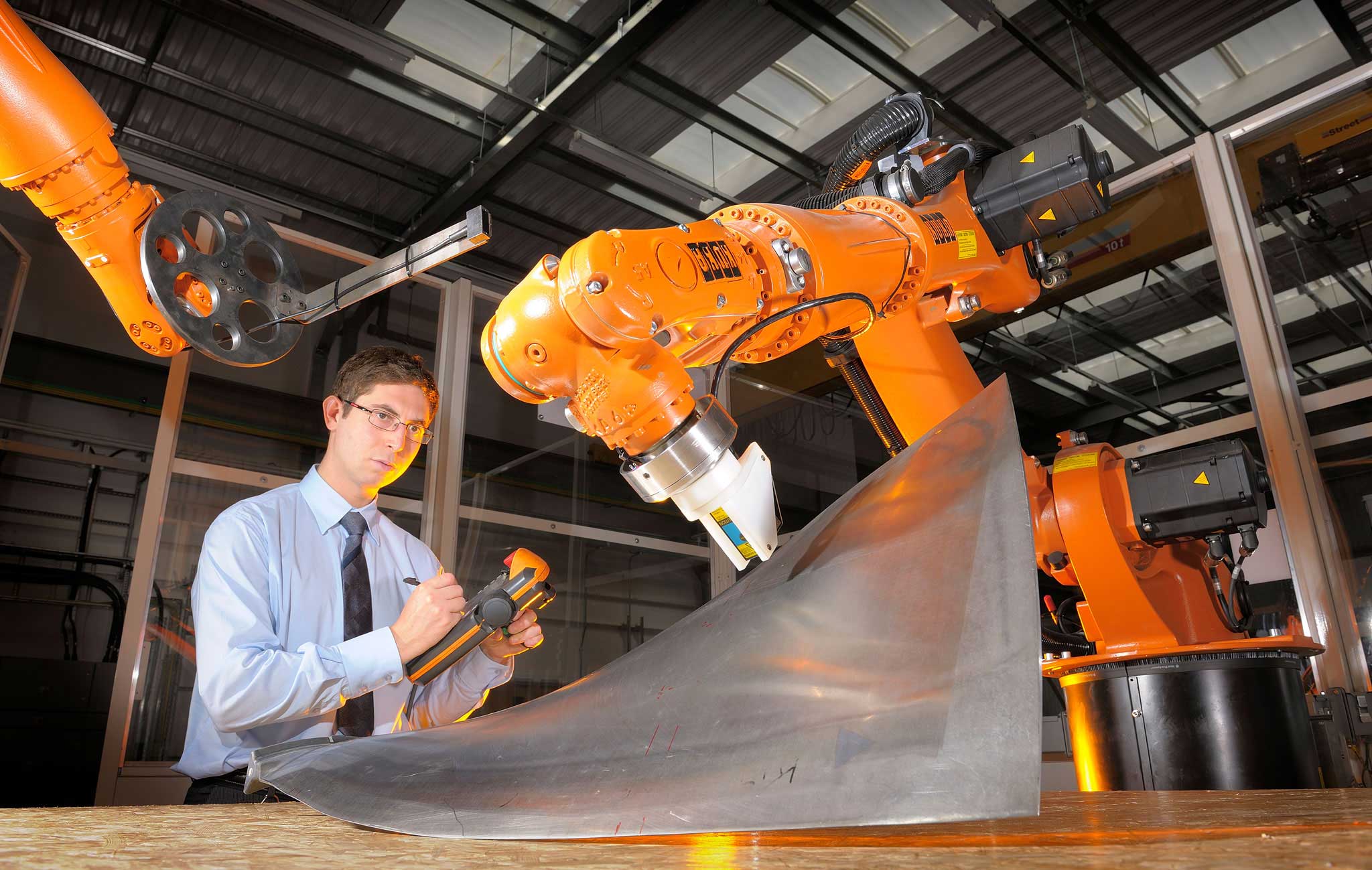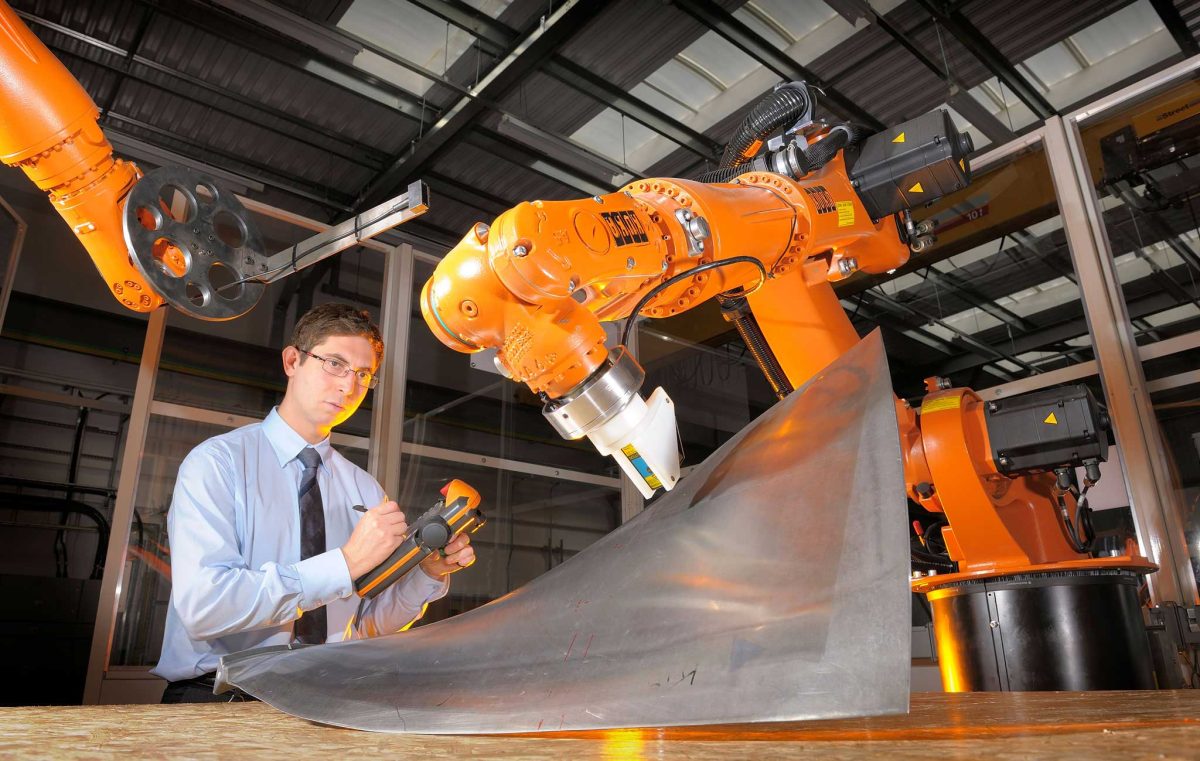
Current NDT test methods include:
Acoustic Emission Testing (AE)

This is a passive NDT technique, which relies on detecting the short bursts of ultrasound emitted by active cracks under a load. Sensors dispersed over the surface the structure detect the AE. It is even possible to detect AE from plasticisation in highly stressed areas before a crack forms. Frequently a method for use during proof tests of a pressure vessel, AE testing is also a continuous Structural Health Monitoring (SHM) method, for example on bridges. Leaks and active corrosion are detectable AE sources too.
Learn more
Electromagnetic Testing (ET)
This testing method uses an electric current or magnetic field which is passed through a conductive part. There are three types of electromagnetic testing, including eddy current testing, alternating current field measurement (ACFM) and remote field testing (RFT).
Eddy current testing uses an alternating current coil to induce an electromagnetic field into the test piece, alternating current field measurement and remote field testing both use a probe to introduce a magnetic field, with RFT generally used to test pipes.
Ground Penetrating Radar (GPR)
This geophysical NDT method sends radar pulses through the surface of a material or subsurface structure, such as rock, ice, water or soil. The waves are reflected or refracted when they encounter a buried object or material boundary with different electromagnetic properties.
Learn more
Laser Testing Methods (LM)
Laser testing falls into three categories including holographic testing, laser profilometry and laser shearography.
Holographic testing uses a laser to detect changes in the surface of the material which has been subjected to stress such as heat, pressure or vibration. The results are then compared to an undamaged reference sample to show defects.
Laser profilometry uses a high speed rotating laser light source and miniature optics to detect corrosion, pitting, erosion and cracks by detecting changes in the surface via a 3D image generated from the surface topography.
Laser shearography uses laser light to create an image before the surface is stressed and a new image is created. These images are compared to one another to determine if any defects are present.
Leak Testing (LT)
Leak testing can be broken down into four different methods – bubble leak testing, pressure change testing, halogen diode testing and mass spectrometer testing.
Bubble leak testing uses a tank of liquid, or a soap solution for larger parts, to detect gas (usually air) leaking from the test piece in the form of bubbles.
Only used on closed systems, pressure change testing uses either pressure or a vacuum to monitor the test piece. A loss of pressure or vacuum over a set time span will show that there is a leak in the system.
Halogen diode testing also uses pressure to find leaks, except in this case air and a halogen-based tracer gas are mixed together and a halogen diode detection unit (or ‘sniffer’) is used to locate any leaks.
Mass spectrometer testing uses helium or a helium and air mix inside a test chamber with a ‘sniffer’ to detect any changes in the air sample, which would indicate a leak. Alternatively, a vacuum can be used, in which case the mass spectrometer will sample the vacuum chamber to detect ionised helium, which will show that there has been a leak.
Magnetic Flux Leakage (MFL)
This method uses a powerful magnet to create magnetic fields which saturate steel structures such as pipelines and storage tanks. A sensor is then used to detect changes in magnetic flux density which show any reduction in material due to pitting, erosion or corrosion.
Microwave Testing
This method is restricted to use on dielectric materials and uses microwave frequencies transmitted and received by a test probe. The test probe detects changes in dielectric properties, such as shrinkage cavities, pores, foreign materials or cracks and displays the results as B or C scans.
Liquid Penetrant Testing (PT)
Liquid penetrant testing involves the application of a fluid with low viscosity to the material to be tested. This fluid seeps into any defects such as cracks or porosity before a developer is applied which allows the penetrant liquid to seep upwards and create a visible indication of the flaw. Liquid penetrant tests can be conducted using solvent removable penetrants, water washable penetrants or post-emulsifiable penetrants.
Magnetic Particle Testing (MT)
Also known as magnetic particle inspection, this NDT process uses magnetic fields to find discontinuities at or near the surface of ferromagnetic materials. The magnetic field can be created with a permanent magnet or an electromagnet, which requires a current to be applied.
The magnetic field will highlight any discontinuities as the magnetic flux lines produce leakage, which can be seen by using magnetic particles that are drawn into the discontinuity.
Neutron Radiographic Testing (NR)
Neutron radiography uses a beam of low energy neutrons to penetrate into the workpiece. While the beam is transparent in metallic materials most organic materials allow the beam to be seen, allowing the structural and internal components to be viewed and examined to detect flaws.
Radiographic Testing (RT)

Radiographic testing uses radiation passed through a test piece to detect defects. X-rays are commonly used for thin or less dense materials while gamma rays are used for thicker or denser items. The results can be processed using film radiography, computed radiography, computed tomography or digital radiography. Whichever method is used, the radiation will show discontinuities in the material due to the strength of the radiation.
Learn more
Thermal/Infrared Testing (IRT)
Infrared testing or thermography uses sensors to determine the wavelength of infrared light emitted from the surface of an object, which can be used to assess its condition.
Passive thermography uses sensors to measure the wavelength of the emitted radiation and if the emissivity is known or can be estimated, the temperature can be calculated and displayed as a digital reading or as a false colour image. This is useful for detecting overheating bearings, motors or electrical components and is widely used to monitor heat loss from buildings.
Active thermography induces a temperature gradient through a structure. Features within it that affect the heat flow result in surface temperature variations that can be analysed to determine the condition of a component. Often used to detect near surface delaminations or bonding defects in composites.
Learn more
Ultrasonic Testing (UT)
Ultrasonic Testing entails the transmission of high frequency soundwave into a material to interact with features within the material that reflect or attenuate it. Ultrasonic testing is broadly divided into Pulse Echo (PE), Through Transmission (TT) and Time of Flight Diffraction (ToFD).
Learn more
Pulse Echo Inspection
This NDT inspection technique introduces a sound beam into the test material surface. The sound will travel through the part, either reaching the rear wall of the material and then returning to the transducer or returning early when reflected from a discontinuity within the part. If the acoustic velocity is known, the time interval recorded is then used to derive the distance travelled in the material.
Through Transmission Testing
TT uses separate transducers to emit and receive the sound. The transmit probe is positioned one side of the test sample and the receive transducer is positioned on the other side. As the sound passes through the component, it is attenuated by features within it, such as porosity. Thickness measurement is not normally possible with this technique.
Time of Flight Diffraction (ToFD)
Diffraction is the process of a change in wavelength in sound as it interacts with a discontinuity in a material. This mechanism is used in situations where a true reflection cannot be obtained but sufficient diffraction occurs to alter the time of flight of the sound in a pitch-catch arrangement. This method is used to detect the tip of a defect that resides perpendicular the probe contact surface. ToFD is also used for rear wall inspection for detection of corrosion.
Immersion Testing
The requirement to wet couple the ultrasound probe to the part can be a challenge for large or complex geometric samples. For convenience these parts are immersed in water – typically in an immersion tank. This method is usually enhanced by actuators that move the part and/or the probe within the tank during ultrasonic inspection.
Learn more
Air Coupled Testing
Certain inspections and materials cannot tolerate the application of wet coupled and so in certain circumstances air coupled ultrasound testing may be performed. This entails the application of sound through an air gap. This typically entails the use of lower frequency inspection.
Electromagnetic Acoustic Transducer (EMAT) Testing
EMAT Testing is a type of non-contact inspection method that uses electromagnetic sound generation and reception without immediate contact or wet coupling with the part. EMATs are of particular use for excessively hot, cold, clean, or dry environments. As with conventional ultrasound, EMATs can produce normal and angled beams as well as other modes, such as guided waves.
Guided Wave Testing (GW)
Ideal for testing pipes over long distances, guided wave testing uses ultrasonic wave forms to reflect changes in the pipe wall, which are then sent to a computer for control and analysis. Guided wave testing can be carried out using medium or long range tests – guided wave medium range ultrasonic testing (GW MRUT) and guided wave long range ultrasonic testing (GW LRUT). GW MRUT techniques cover an area of 25mm to 3000mm, while GW LRUT covers distances greater than this and can be used to inspect areas over hundreds of metres from one location.
Advanced Ultrasonic Methods
Automated Inspection
The benefit of automation is achieved by the integration of NDT sensors with standard commercially available industrial robots as well as collaborative robots, also known as “cobots”. Custom written software for acquiring and visualising data creates a seamless and intuitive user experience that can be adapted to specific needs.
TWI has developed several highly capable automated inspection systems suited to both research and development work as well as production inspection.
Phased Array Ultrasonic Testing (PAUT)

PAUT probes are different from conventional UT probes in that they consist of an array of individual elements that can be pulsed independently. By controlling the times at which each element is fired, sound beams can be focussed or steered. By sweeping the beam through a range of angles or depths, cross-sectional views can be generated using one probe where several probe and wedge combinations may have been required with conventional UT. A virtual probe can be created from a number of elements and this can be electronically indexed along the length of the array to create a wide paintbrush scan.
Learn more
Full Matrix Capture (FMC)
FMC is an evolution of the PAUT technique and uses the same probes. Its main advantage is that there is no need to focus or steer the beam as the entire area of interest is in focus. It is also relatively tolerant of misaligned flaws and structural noise. This makes it very easy to set up and use. The disadvantage is that the file sizes are very large and the acquisition speed can be slower than with PAUT.
Learn more
Virtual Source Aperture (VSA)
VSA is a variation on FMC that retains most of the advantages of its superior image quality, but with greatly reduced file sizes and acquisition speeds that can exceed that of PAUT.
Vibration Analysis (VA)
This process uses sensors to measure the vibration signatures from rotating machinery in order to assess the condition of the equipment. The types of sensors used include displacement sensors, velocity sensors, and accelerometers.
Learn more
Visual Testing (VT)
Visual testing also known as visual inspection is one of the most common techniques which involves the operator looking at the test piece. This can be aided by the use of optical instruments such as magnifying glasses or computer-assisted systems (known as ‘Remote Viewing’).
This method allows for the detection of corrosion, misalignment, damage, cracks, and more. Visual testing is inherent in most other types of NDT as they will generally require an operator to look for defects.
TWI has a wide range of industrial NDT services.
Find out which areas we can assist you in by visiting our non-destructive testing service pages below, or email us to find out how we can help:
contactus@twi.co.uk





